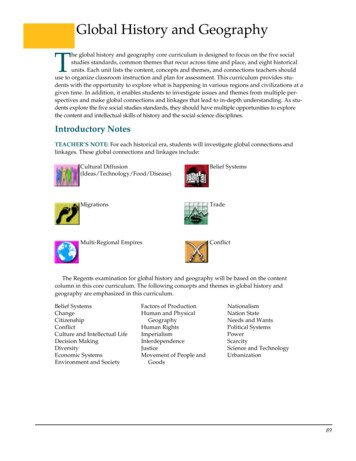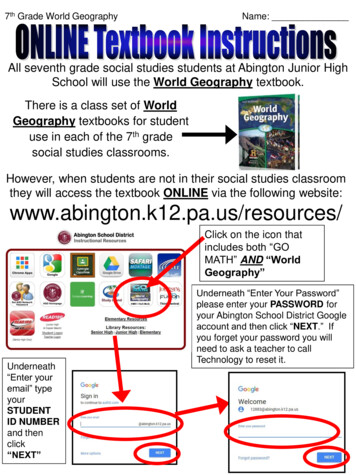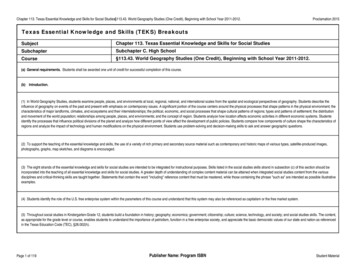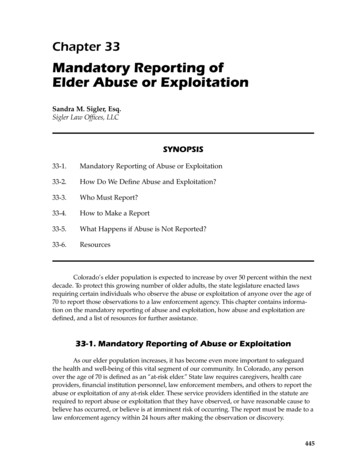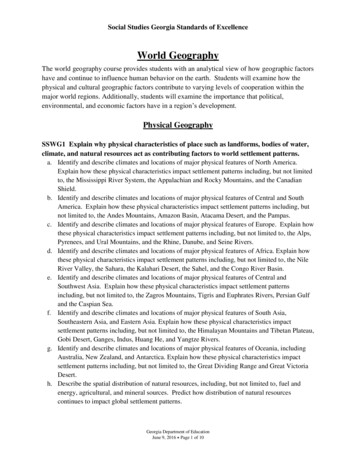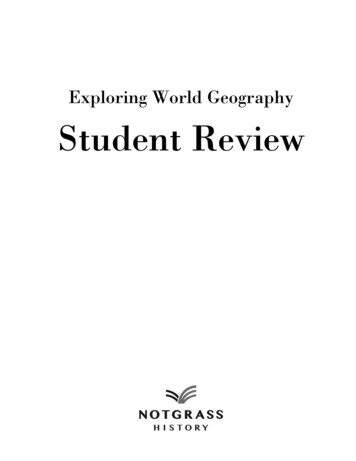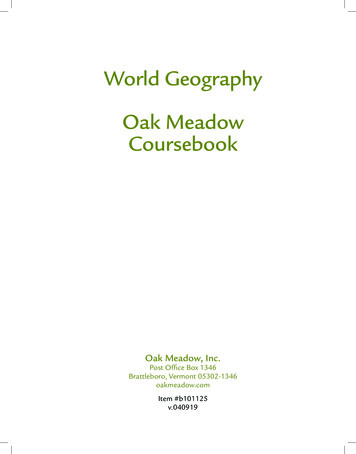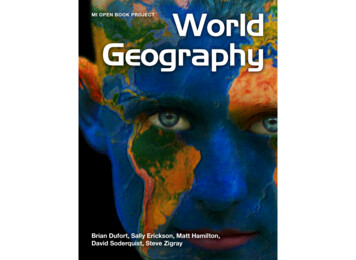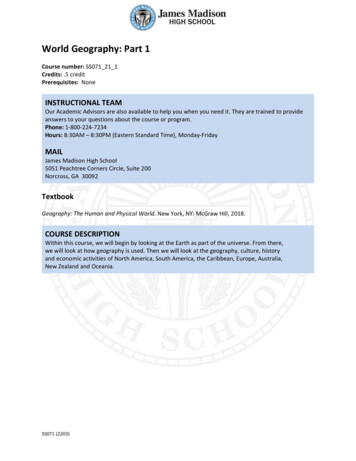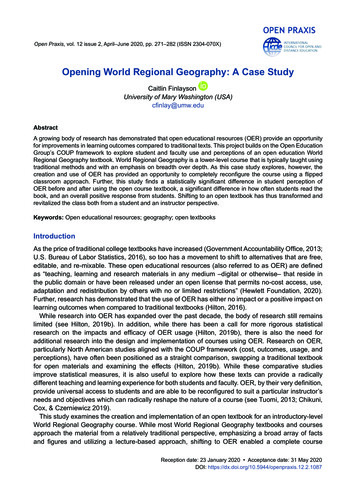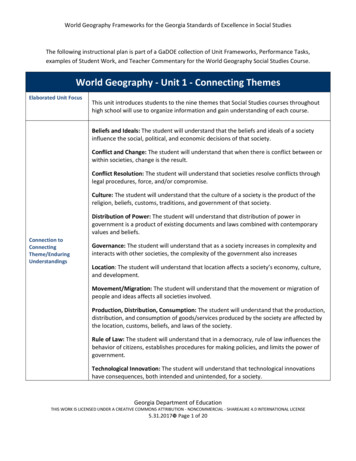
Transcription
World Geography Frameworks for the Georgia Standards of Excellence in Social StudiesThe following instructional plan is part of a GaDOE collection of Unit Frameworks, Performance Tasks,examples of Student Work, and Teacher Commentary for the World Geography Social Studies Course.World Geography - Unit 1 - Connecting ThemesElaborated Unit FocusThis unit introduces students to the nine themes that Social Studies courses throughouthigh school will use to organize information and gain understanding of each course.Beliefs and Ideals: The student will understand that the beliefs and ideals of a societyinfluence the social, political, and economic decisions of that society.Conflict and Change: The student will understand that when there is conflict between orwithin societies, change is the result.Conflict Resolution: The student will understand that societies resolve conflicts throughlegal procedures, force, and/or compromise.Culture: The student will understand that the culture of a society is the product of thereligion, beliefs, customs, traditions, and government of that society.Distribution of Power: The student will understand that distribution of power ingovernment is a product of existing documents and laws combined with contemporaryvalues and beliefs.Connection : The student will understand that as a society increases in complexity andinteracts with other societies, the complexity of the government also increasesLocation: The student will understand that location affects a society’s economy, culture,and development.Movement/Migration: The student will understand that the movement or migration ofpeople and ideas affects all societies involved.Production, Distribution, Consumption: The student will understand that the production,distribution, and consumption of goods/services produced by the society are affected bythe location, customs, beliefs, and laws of the society.Rule of Law: The student will understand that in a democracy, rule of law influences thebehavior of citizens, establishes procedures for making policies, and limits the power ofgovernment.Technological Innovation: The student will understand that technological innovationshave consequences, both intended and unintended, for a society.Georgia Department of EducationTHIS WORK IS LICENSED UNDER A CREATIVE COMMONS ATTRIBUTION - NONCOMMERCIAL - SHAREALIKE 4.0 INTERNATIONAL LICENSE5.31.2017 Page 1 of 20
World Geography Frameworks for the Georgia Standards of Excellence in Social StudiesGSE for Social Studies(standards andelements)The focus of this unit is to teach the Enduring Understandings or themes to students to build theirframework for understanding the course.There are no GSE selected for this introductory unit.Connection to LiteracyStandards for SocialStudies (readingand/or writing)Connection to SocialStudies Matrices(informationprocessing and/or mapand globe skills)Georgia Department of EducationTHIS WORK IS LICENSED UNDER A CREATIVE COMMONS ATTRIBUTION - NONCOMMERCIAL - SHAREALIKE 4.0 INTERNATIONAL LICENSE5.31.2017 Page 2 of 20
World Geography Frameworks for the Georgia Standards of Excellence in Social StudiesEssential Questions and Related Supporting/Guiding gEnduringUnderstandingHow does where we live affect how we live?1. How does environment affect culture?2. How does our work reflect where we live?3. Why is government shaped by location?How can a place cause conflict?1. Why would countries fight over a place?2. Why might states fight over a place?3. Why might individuals fight over a place?How can we have both progress and a healthy environment?1. What role should a government play in the environment?2. Who’s responsible for protecting the environment?3. How is economic growth tied to the environment?Georgia Department of EducationTHIS WORK IS LICENSED UNDER A CREATIVE COMMONS ATTRIBUTION - NONCOMMERCIAL - SHAREALIKE 4.0 INTERNATIONAL LICENSE5.31.2017 Page 3 of 20
World Geography Frameworks for the Georgia Standards of Excellence in Social StudiesSample Instructional Activities/AssessmentsWhat is Geography?Students will examine the question “What is Geography?”1. In groups, give students 1 source on the field of geography from the source list below.2. Allow them 5 minutes to analyze their source in the context of answering the question above.3. When time expires allow groups 3 minutes to discuss what they read and how it answers thequestion.4. Allow each group to share their response to the question based on their source. Collectresponses on the board.5. Individually, allow students to write their own answer to the question using information sharedfrom all groups.Sources for Student Research: (printable sources below)Emergence of Modern Geography by National Geographic ography/Ancient Geographers by National Geographic ography/What is Geography from the Royal Geography Society http://www.rgs.org/GeographyToday/What is geography.htmWhat is Geography? Video from Study.com -definition-facts-types.htmlGSE Standards andElementsN/ALiteracy StandardsSocial Studies MatricesEnduringUnderstanding(s)N/AGeorgia Department of EducationTHIS WORK IS LICENSED UNDER A CREATIVE COMMONS ATTRIBUTION - NONCOMMERCIAL - SHAREALIKE 4.0 INTERNATIONAL LICENSE5.31.2017 Page 4 of 20
World Geography Frameworks for the Georgia Standards of Excellence in Social StudiesEmergence of Modern Geography by National GeographicSome people have trouble understanding the complete scope of the discipline of geographybecause, unlike most other disciplines, geography is not defined by one particular topic. Instead,geography is concerned with many different topics—people, culture, politics, settlements, plants,landforms, and much more.What distinguishes geography is that it approaches the study of diverse topics in a particularway (that is, from a particular perspective). Geography asks spatial questions—how and why things aredistributed or arranged in particular ways on Earth’s surface. It looks at these different distributions andarrangements at many different scales. It also asks questions about how the interaction of differenthuman and natural activities on Earth’s surface shape the characteristics of the world in which we live.Geography seeks to understand where things are found and why they are present in thoseplaces; how things that are located in the same or distant places influence one another over time; andwhy places and the people who live in them develop and change in particular ways. Raising thesequestions is at the heart of the “geographic perspective.”Exploration has long been an important part of geography. But exploration no longer simplymeans going to places that have not been visited before. It means documenting and trying to explain thevariations that exist across the surface of Earth, as well as figuring out what those variations mean forthe future.The age-old practice of mapping still plays an important role in this type of exploration, butexploration can also be done by using images from satellites or gathering information from interviews.Discoveries can come by using computers to map and analyze the relationship among things ingeographic space, or from piecing together the multiple forces, near and far, that shape the wayindividual places develop.Applying a geographic perspective demonstrates geography’s concern not just with wherethings are, but with “the why of where”—a short, but useful definition of geography’s central focus.The insights that have come from geographic research show the importance of asking “the whyof where” questions. Geographic studies comparing physical characteristics of continents on either sideof the Atlantic Ocean, for instance, gave rise to the idea that Earth’s surface is comprised of large, slowlymoving plates—plate tectonics.Studies of the geographic distribution of human settlements have shown how economic forcesand modes of transport influence the location of towns and cities. For example, geographic analysis hasGeorgia Department of EducationTHIS WORK IS LICENSED UNDER A CREATIVE COMMONS ATTRIBUTION - NONCOMMERCIAL - SHAREALIKE 4.0 INTERNATIONAL LICENSE5.31.2017 Page 5 of 20
World Geography Frameworks for the Georgia Standards of Excellence in Social Studiespointed to the role of the U.S. Interstate Highway System and the rapid growth of car ownership increating a boom in U.S. suburban growth after World War II. The geographic perspective helped showwhere Americans were moving, why they were moving there, and how their new living places affectedtheir lives, their relationships with others, and their interactions with the environment.Geographic analyses of the spread of diseases have pointed to the conditions that allowparticular diseases to develop and spread. Dr. John Snow’s cholera map stands out as a classic example.When cholera broke out in London, England, in 1854, Snow represented the deaths per household on astreet map. Using the map, he was able to trace the source of the outbreak to a water pump on thecorner of Broad Street and Cambridge Street. The geographic perspective helped identify the source ofthe problem (the water from a specific pump) and allowed people to avoid the disease (avoiding waterfrom that pump).Investigations of the geographic impact of human activities have advanced understanding of therole of humans in transforming the surface of Earth, exposing the spatial extent of threats such as waterpollution by manmade waste. For example, geographic study has shown that a large mass of tiny piecesof plastic currently floating in the Pacific Ocean is approximately the size of Texas. Satellite images andother geographic technology identified the so-called “Great Pacific Garbage Patch.”These examples of different uses of the geographic perspective help explain why geographicstudy and research is important as we confront many 21st century challenges, including environmentalpollution, poverty, hunger, and ethnic or political conflict.Because the study of geography is so broad, the discipline is typically divided into specialties. Atthe broadest level, geography is divided into physical geography, human geography, geographictechniques, and regional geography.Georgia Department of EducationTHIS WORK IS LICENSED UNDER A CREATIVE COMMONS ATTRIBUTION - NONCOMMERCIAL - SHAREALIKE 4.0 INTERNATIONAL LICENSE5.31.2017 Page 6 of 20
World Geography Frameworks for the Georgia Standards of Excellence in Social StudiesAncient Geographers by National GeographicThe term "geography" comes to us from the ancient Greeks, who needed a word to describe thewritings and maps that were helping them make sense of the world in which they lived. InGreek, geo means “earth” and -graphy means “to write.” Using geography, Greeks developedan understanding of where their homeland was located in relation to other places, what theirown and other places were like, and how people and environments were distributed. Theseconcerns have been central to geography ever since.Of course, the Greeks were not the only people interested in geography. Throughout humanhistory, most societies have sought to understand something about their place in the world, andthe people and environments around them.Indeed, mapmaking probably came even before writing in many places. But ancient Greekgeographers were particularly influential. They developed very detailed maps of areas in andaround Greece, including parts of Europe, Africa, and Asia. More importantly, they also raisedquestions about how and why different human and natural patterns came into being on Earth’ssurface, and why variations existed from place to place. The effort to answer these questionsabout patterns and distribution led them to figure out that the world was round,to calculate Earth’s circumference, and to develop explanations of everything from the seasonalflooding of the Nile River to differences in population densities from place to place.During the Middle Ages, geography ceased to be a major academic pursuit in Europe. Advancesin geography were chiefly made by scientists of the Muslim world, based around the ArabianPeninsula and North Africa. Geographers of this Islamic Golden Age created the world’s firstrectangular map based on a grid, a map system that is still familiar today. Islamic scholars alsoapplied their study of people and places to agriculture, determining which cropsand livestock were most suited to specific habitats or environments.In addition to the advances in the Middle East, the Chinese empire in Asia also contributedimmensely to geography. Until about 1500, China was the most prosperous civilization on Earth.The Chinese were scientifically advanced, especially in the field of astronomy. Around 1000,they also achieved one of the most important developments in the history of geography: Theywere the first to use the compass for navigational purposes. In the early 1400s,the explorer Cheng Ho embarked on seven voyages to the lands bordering the China Sea and theIndian Ocean, establishing China’s dominance throughout Southeast Asia.Georgia Department of EducationTHIS WORK IS LICENSED UNDER A CREATIVE COMMONS ATTRIBUTION - NONCOMMERCIAL - SHAREALIKE 4.0 INTERNATIONAL LICENSE5.31.2017 Page 7 of 20
World Geography Frameworks for the Georgia Standards of Excellence in Social StudiesWhat is geography? From the Royal Geography SocietyGeography is the study of Earth’s landscapes, peoples, places and environments. It is, quite simply,about the world in which we live.Geography is unique in bridging the social sciences (human geography) with the natural sciences(physical geography). Human geography concerns the understanding of the dynamics of cultures,societies and economies, and physical geography concerns the understanding of the dynamics ofphysical landscapes and the environment.Geography puts this understanding of social and physical processes within the context of places andregions - recognizing the great differences in cultures, political systems, economies, landscapes andenvironments across the world, and the links between them. Understanding the causes of differences andinequalities between places and social groups underlie much of the newer developments in humangeography.Geography provides an ideal framework for relating other fields of knowledge. It is not surprising thatthose trained as geographers often contribute substantially to the applied management of resources andenvironments.Geography is, in the broadest sense, an education for life and for living. Learning through geography –whether gained through formal learning or experientially through travel, fieldwork and expeditions – helpsus all to be more socially and environmentally sensitive, informed and responsible citizens andemployees.Geography informs us about The places and communities in which we live and work Our natural environments and the pressures they face The interconnectedness of the world and our communities within it How and why the world is changing, globally and locally How our individual and societalactions contribute to those changes The choices that exist in managing our world for the future The importance of location in business and decision-makingGeorgia Department of EducationTHIS WORK IS LICENSED UNDER A CREATIVE COMMONS ATTRIBUTION - NONCOMMERCIAL - SHAREALIKE 4.0 INTERNATIONAL LICENSE5.31.2017 Page 8 of 20
World Geography Frameworks for the Georgia Standards of Excellence in Social StudiesDefinition of GEOGRAPHYFROMM ERRIAM -WEBSTER DICTIONARY: a science that deals with the description, distribution, and interactionof the diverse physical, biological, and cultural features of the earth'ssurfaceWhat is Geography Video from geography-definition-facts-types.htmlGeorgia Department of EducationTHIS WORK IS LICENSED UNDER A CREATIVE COMMONS ATTRIBUTION - NONCOMMERCIAL - SHAREALIKE 4.0 INTERNATIONAL LICENSE5.31.2017 Page 9 of 20
World Geography Frameworks for the Georgia Standards of Excellence in Social StudiesGeography is Everything.After students can explain the concept of world geography, give them a copy of the connecting themes.1. Ask students to bring in an article of their choice. (paper or on a device)2. In small groups have students take turns summarizing their article--30 seconds each.3. Allow groups 4-5 minutes to discuss how each article connects to the topic of world geography,AND choose 1 connecting theme that aligns to the main idea of the article.4. Allow each group to share an interesting connection to world geography/connecting themes withthe whole class.5. If a group has an article they believe does not connect to world geography, have them summarizethe article and see if the whole class can make a connection.GSE Standards andElementsN/ALiteracy StandardsSocial Studies MatricesEnduringUnderstanding(s)N/AGeorgia Department of EducationTHIS WORK IS LICENSED UNDER A CREATIVE COMMONS ATTRIBUTION - NONCOMMERCIAL - SHAREALIKE 4.0 INTERNATIONAL LICENSE5.31.2017 Page 10 of 20
World Geography Frameworks for the Georgia Standards of Excellence in Social StudiesVisualize ItIndividually, have students choose one of the connecting themes/enduring understandings that theythink is the most important. Have students create a T-shirt design for their selected theme with thefollowing elements: 1 photograph/image that is a good example of this themeA slogan for the themeAn appropriate caption relating to the photo and the themeGSE Standards andElementsN/ALiteracy StandardsAll enduring understandingsSocial Studies LESS someone like you cares a whole awfullot, nothing is going to get better. It’s not.Georgia Department of EducationTHIS WORK IS LICENSED UNDER A CREATIVE COMMONS ATTRIBUTION - NONCOMMERCIAL - SHAREALIKE 4.0 INTERNATIONAL LICENSE5.31.2017 Page 11 of 20
World Geography Frameworks for the Georgia Standards of Excellence in Social StudiesGeorgia Department of EducationTHIS WORK IS LICENSED UNDER A CREATIVE COMMONS ATTRIBUTION - NONCOMMERCIAL - SHAREALIKE 4.0 INTERNATIONAL LICENSE5.31.2017 Page 12 of 20
World Geography Frameworks for the Georgia Standards of Excellence in Social StudiesCulminating Unit Performance TaskA Picture is Worth Break students into small groups, give each group a list of the connecting themes and one of the images below. Note: thelinks below have source information, the printable images do not. Do not share this information with students yet.Sources (printable versions below)1.2.3.4.5.6.7.Dinka Cattle Camp, Southern Sudan t/dinka-cattlecamp/nAFD5gUypXaVswParcelling out of the Hacienda Satavento, in the Veracruz suburb- n City, Beijing, China tectural-landmarks-in-beijijngPacific Gyre Garbage Patch in Central North Pacific Ocean l-disasters-in-history/No Man’s Land, Once a Forest in Flander’s 6fW RtQNRC2KgrbL5igChernobyl 29 years after the nuclear accident umbo.jpgAgricultural/Farming Drones in the U.S. es-agriculturebusiness-military-2017-8Group Instructions: Examine your image, as a group write a story from the point of view of someone in the image or theperson taking the picture. Choose one of the connecting themes as a basis for your story line.After each group has written their story, have groups share their photo and story with another group. The listening groupsshould try to guess which connecting theme is the basis for the story (note: though a group will choose one connectingtheme, it is likely that many themes may be present in the story. The listening group can explain what parts of the storylead them to think a theme is correct)GSE Standards andElementsN/ALiteracy StandardsN/ASocial Studies MatricesEnduringUnderstanding(s)Georgia Department of EducationTHIS WORK IS LICENSED UNDER A CREATIVE COMMONS ATTRIBUTION - NONCOMMERCIAL - SHAREALIKE 4.0 INTERNATIONAL LICENSE5.31.2017 Page 13 of 20
World Geography Frameworks for the Georgia Standards of Excellence in Social StudiesGeorgia Department of EducationTHIS WORK IS LICENSED UNDER A CREATIVE COMMONS ATTRIBUTION - NONCOMMERCIAL - SHAREALIKE 4.0 INTERNATIONAL LICENSE5.31.2017 Page 14 of 20
World Geography Frameworks for the Georgia Standards of Excellence in Social StudiesGeorgia Department of EducationTHIS WORK IS LICENSED UNDER A CREATIVE COMMONS ATTRIBUTION - NONCOMMERCIAL - SHAREALIKE 4.0 INTERNATIONAL LICENSE5.31.2017 Page 15 of 20
World Geography Frameworks for the Georgia Standards of Excellence in Social StudiesGeorgia Department of EducationTHIS WORK IS LICENSED UNDER A CREATIVE COMMONS ATTRIBUTION - NONCOMMERCIAL - SHAREALIKE 4.0 INTERNATIONAL LICENSE5.31.2017 Page 16 of 20
World Geography Frameworks for the Georgia Standards of Excellence in Social StudiesGeorgia Department of EducationTHIS WORK IS LICENSED UNDER A CREATIVE COMMONS ATTRIBUTION - NONCOMMERCIAL - SHAREALIKE 4.0 INTERNATIONAL LICENSE5.31.2017 Page 17 of 20
World Geography Frameworks for the Georgia Standards of Excellence in Social StudiesGeorgia Department of EducationTHIS WORK IS LICENSED UNDER A CREATIVE COMMONS ATTRIBUTION - NONCOMMERCIAL - SHAREALIKE 4.0 INTERNATIONAL LICENSE5.31.2017 Page 18 of 20
World Geography Frameworks for the Georgia Standards of Excellence in Social StudiesGeorgia Department of EducationTHIS WORK IS LICENSED UNDER A CREATIVE COMMONS ATTRIBUTION - NONCOMMERCIAL - SHAREALIKE 4.0 INTERNATIONAL LICENSE5.31.2017 Page 19 of 20
World Geography Frameworks for the Georgia Standards of Excellence in Social StudiesGeorgia Department of EducationTHIS WORK IS LICENSED UNDER A CREATIVE COMMONS ATTRIBUTION - NONCOMMERCIAL - SHAREALIKE 4.0 INTERNATIONAL LICENSE5.31.2017 Page 20 of 20
examples of Student Work, and Teacher Commentary for the World Geography Social Studies Course. World Geography - Unit 1 - Connecting Themes Elaborated Unit Focus This unit introduces students to the nine themes that Social Studies courses throughout high school will use to organize informa
